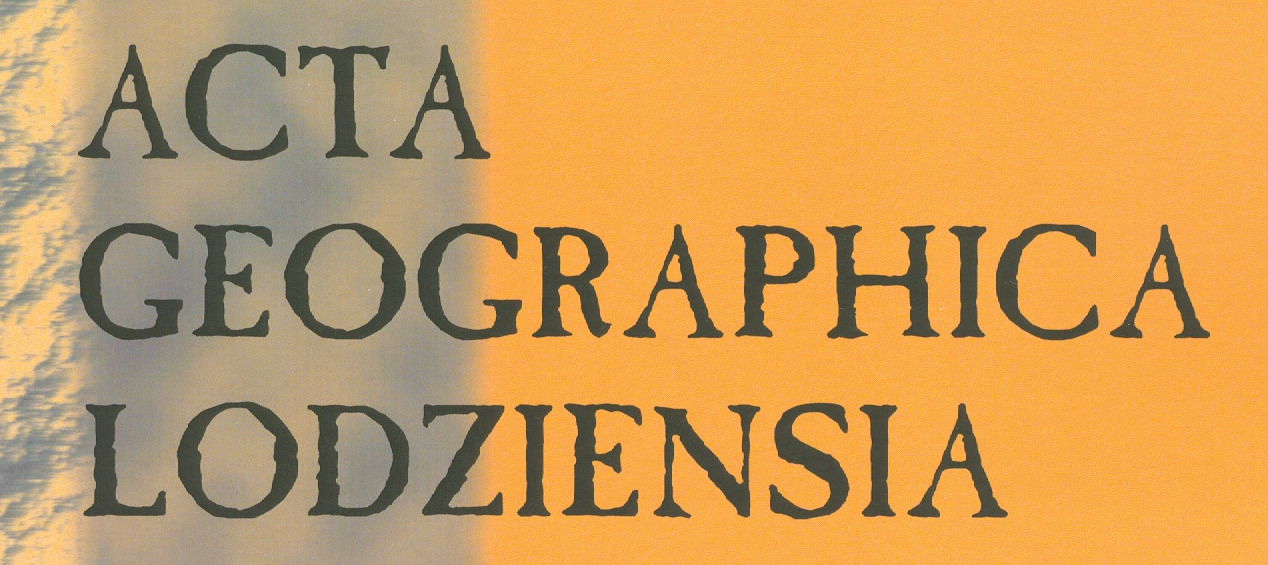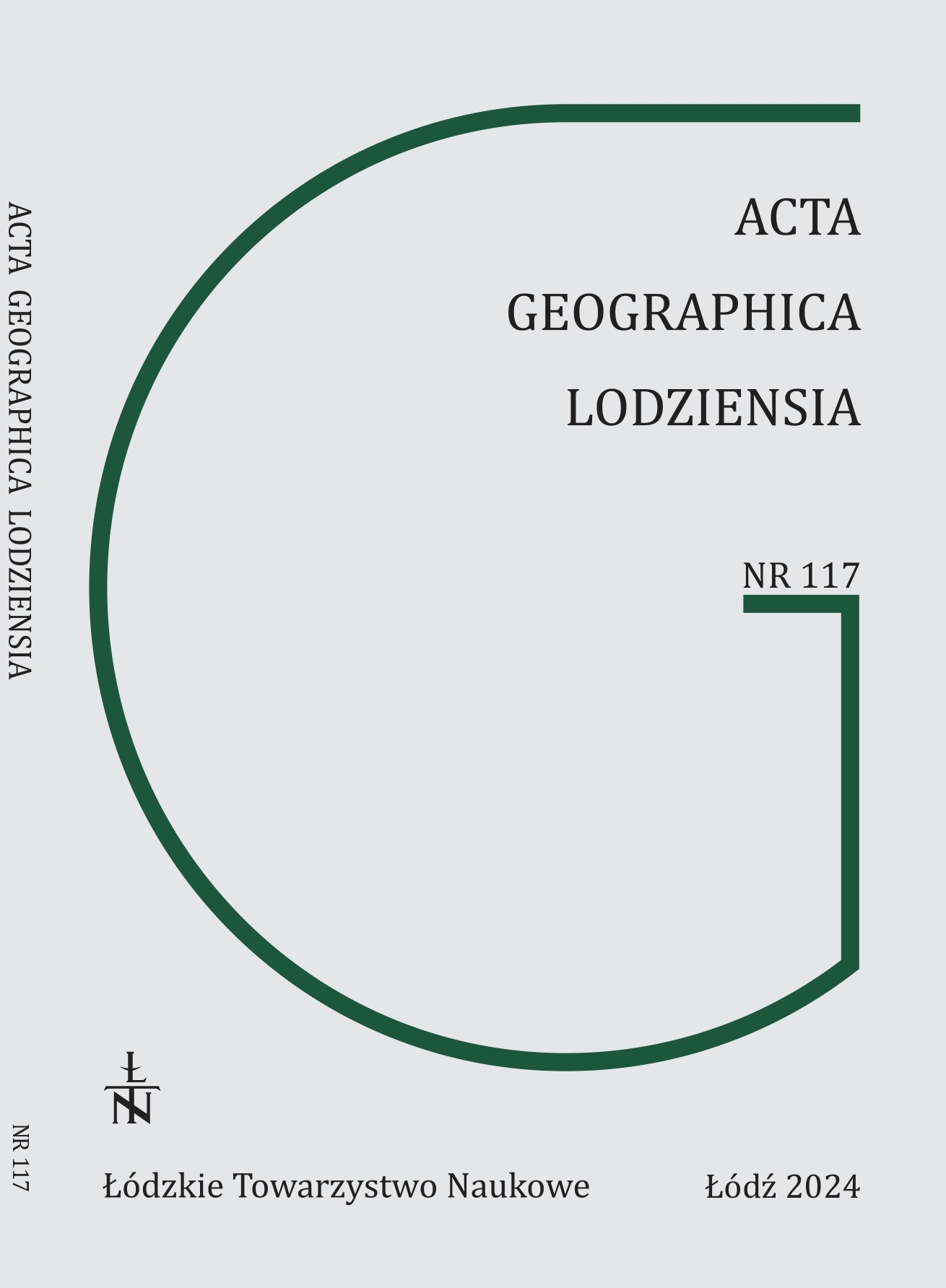Antropogeniczne i biogeniczne składowe strumienia dwutlenku węgla w Łodzi
DOI:
https://doi.org/10.26485/AGL/2024/117/5Słowa kluczowe:
miasto, turbulencyjna wymiana dwutlenku węgla, strumień antropogeniczny, strumień biogeniczny, podział strumienia nettoAbstrakt
Metoda kowariancji wirów pozwala na określenie dobowej, sezonowej i rocznej pionowej wymiany dwutlenku węgla pomiędzy powierzchnią miejską a atmosferą. Jednakże pomiary te nie zawierają informacji o tym jakie procesy wpływają na intensywność i kierunek tej wymiany. W przypadku obszarów zurbanizowanych o intensywności wymiany CO2 decydują zarówno procesy biogeniczne (jako efekt obecności roślinności miejskiej), jak i procesy związane z działalnością człowieka (np. oddychanie ludzi i spalanie paliw kopalnych). Celem opracowania jest prezentacja wstępnych wyników wyznaczania bio- i antropogenicznych składowych wymiany CO2 w Łodzi. W tym celu zastosowano statystyczne podejście zaproponowane przez Menzera i McFaddena dla miast amerykańskich (Menzer, McFadden 2017). Do analizy wykorzystano dane z lat 2012–2015 ze stanowiska pomiarowego przy ul. Lipowej 81 położonego w zachodniej części centrum Łodzi. Wyniki wskazują, że wszystkie antropogeniczne składowe strumienia CO2 netto wyznaczone dla wybranego fragmentu centrum Łodzi mają wartości dodatnie, zatem wskazują na emisje tego gazu do atmosfery. Najistotniejszą składową strumienia CO2 netto w Łodzi jest, niezależnie od pory roku, strumień związany ze spalaniem paliw kopalnych w silnikach samochodów. W chłodnej połowie roku istotną rolę pełni również strumień związany z ogrzewaniem mieszkań.
Bibliografia
Ao X., Grimmond C.S.B., Chang Y., Liu D., Tang Y., Hu P., Wang Y., Zou J., Tan J. 2016. Heat, water and carbon exchanges in the tall megacity of Shanghai: challenges and results. International Journal of Climatology 36: 4608-4624.
Aubinet M., Vesala T., Papale D. 2012. Eddy Covariance. A Practical Guide to Measurement and Data Analysis. Springer Netherlands.
Bezyk Y., Sówka I., Górka M. 2021. Assessment of urban CO¬2 budget: Anthropogenic and biogenic inputs. Urban Climate 39: 100949.
Bezyk Y., Górka M., Sówka I., Nęcki J., Strąpoć D. 2023. Temporal dynamics and controlling factors of CO2 and CH4 variability in the urban atmosphere of Wroclaw, Poland. Science of Total Environment 893: 164771.
Björkegren A., Grimmond C.S.B. 2018. Net carbon dioxide emissions form central London. Urban Climate 23: 131-158.
Buckley S.M., Mitchell M.J., McHale P.J., Millard G.D. 2016. Variations in carbon dioxide fluxes witin a city landscape: Identifying a vehicular influence. Urban Ecosystems 19: 1479-1498. Burba G. 2021. Eddy Covariance Method for Scientific, Regulatory, and Commercial Applications. LI-COR Biosciences. Lincoln. Nebraska.
Chamberlain S.D., Ingraffea A.R., Sparks J.P. 2016. Sourcing methane and carbon dioxide emissions from a small city: Influence of natural gas leakage and combustion. Environmental Pollution 218: 102-110.
Christen A. 2014. Atmospheric measurement techniques to quantify greenhouse gas emissions from cities. Urban Climate 10: 241-260.
Christen A., Vogt R. 2004. Energy and radiation balance of a Central European city. International Journal of Climatology 24: 1395-1421.
Duan X., Gao Z., Xu Q., Zhou S., Qion K., Yang Y. 2022. A benchmark dataset of diurnal- and seasonal-scale radiation, heat, and CO2 fluxes in a typical East Asian monsoon region. Eearth System Science Data 14: 4153-4169.
Foken T. 2008. Micrometeorology. Springer, Berlin.
Fortuniak K. 2003. Miejska wyspa ciepła. Podstawy energetyczne, studia eksperymentalne, modele numeryczne i statystyczne. Wyd. Uniwersytetu Łódzkiego.
Fortuniak K. 2010. Radiacyjne i turbulencyjne składniki bilansu cieplnego terenów zurbanizowanych na przykładzie Łodzi. Wyd. Uniwersytetu Łódzkiego.
Fortuniak K., Pawlak W. 2015. Selected spectral characterics of turbulence over an urbanized area in the center of Łódź, Poland. Boundary Layer Meteorology 154: 137-156.
Fortuniak K., Pawlak W., Siedlecki M. 2013. Integral turbulence statistics over a central european city centre. Boundary Layer Meteorology 146: 257-276.
Gioli B., Toscano P., Lugato E., Matese A., Miglietta F., Zaldei A., Vaccari F.P. 2012. Methane and carbon dioxide fluxes and source partitioning in urban areas: The case study of Florence, Italy. Environmental Pollution 164: 125-131.
Google Earth. 2024. Online: https://earth.google. com (data ostatniego dostępu: 01.03.2024).
Goret M., Masson V., Schoetter R., Moine M.P. 2019. Inclusion of CO2 flux modelling in an urban canopy layer model and an evaluation over an old European city centre. Atmospheric Environment: X 3: 100042.
Grimmond C.S.B., Oke T.R. 1999. Aerodynamic properties of urban areas derived from analysis of surface form. Journal of Applied Meteorology 38: 1262-1292.
Helfter C., Tremper A.H., Halios C.H., Kotthaus S., Bjorkegren A., Grimmond C.S.B., Barlow J.F., Nemitz E. 2016. Spatial and temporal variability 1 of urban fluxes of methane, carbon monoxide and carbon dioxide above London, UK. Atmospheric Chemistry and Physics 16: 10543-10557.
IPCC. 2023. Lee H., Romero J. (red.). Climate Change 2023: Synthesis Report. Contribution of Working Groups I, II and III to the Sixth Assessment Report of the Intergovernmental Panel on Climate Change. IPCC, Geneva, Szwajcaria.
Jasek A., Zimnoch M., Gorczyca Z., Smula E., Rożański K. 2014. Seasonal variability of soil CO2 flux and its carbon isotope composition in Krakow urban area, Southern Poland. Isotopes in Environmental and Health Studies 50: 143-155.
Jasek-Kamińska A., Zimnoch M., Wachniew P., Różański K. 2020. Urban CO2 Budget: Spatial and Seasonal Variability of CO2 Emissions in Krakow, Poland. Atmosphere 11(6): 629.
Järvi L., Havu M., Ward H.C., Bellucco V., McFadden J.P., Tiovonen T., Heikinheimo V., Kolari P., Riikonen A., Grimmond C.S.B. 2018. Spatial modelling of local-scale biogenic and anthropogenic carbon dioxide emissions in Helsinki. Journal of Geophysical Research – Atmospheres 124(15): 8363-8384.
Kleingeld E., van Hove B., Elbers J., Jacobs C. 2018. Carbon dioxide fluxes in the city centre of Arnhem, a middle-sized Dutch city. Urban Climate 24: 994-1010.
Kłysik K. 1998. Charakterystyka powierzchni miejskiej Łodzi z klimatologicznego punktu widzenia. Acta Universitatis Lodziensis – Folia Geographica Physica 3: 173-185.
Kotthaus S., Grimmond C.S.B. 2014a. Energy exchange in a dense urban environment – Part I: Temporal variability of long-term observations in central London. Urban Climate 10: 261-280.
Kotthaus S., Grimmond C.S.B. 2014b. Energy exchange in a dense urban environment – Part II: Impact of spatial heterogeneity of the Surface. Urban Climate 10: 281-307.
Lee X., Massman W., Law B. 2004. Handbook of Micrometeorology. A guide for surface flux measurement and analysis. Kluwer Academic Publishers. Dordrecht.
Matthews B., Schume H. 2022. Tall tower eddy covariance measurements of CO2 fluxes in Vienna, Austria. Atmospheric Environment 274: 118941.
Menzer O., McFadden J.P. 2017. Statistical partitioning of a three-year time series of direct urban net CO2 flux measurements into biogenic and anthropogenic components, Atmospheric Environment 170: 319-333.
Moriwaki R., Kanda M. 2004. Seasonal and diurnal fluxes of radiation, heat, water vapor, and carbon dioxide over a suburban area. Journal of Applied Meteorology 43: 1700-1710.
Nicolini G., Castaldi S., Fratini G., Valentini R. 2013. A literature overview of micrometeorological CH4 and N2O flux measurements in terrestrial ecosystems. Atmospheric Environment 81: 311-319.
Nordbo A., Järvi L., Haapanala S., Wood C.R., Vesala T. 2012. Fraction of natural area as main predictor of net CO2 emissions from cities. Geophysical Research Letters 39: L20802.
Offerle B., Grimmond C.S.B., Fortuniak K., Kłysik K., Oke T.R. 2006a. Temporal variations in heat fluxes over a central European city centre. Theoretical and Applied Climatology 84: 103-115.
Offerle B., Grimmond C.S.B., Fortuniak K., Pawlak W. 2006b. Intra-urban differences of surface energy fluxes in a central European city. Journal of Applied Meteorology and Climatology 45: 125-136.
Oke TR., Mills G., Christen A., Voogt J.A. 2017. Urban Climates. Cambridge University Press, UK.
Pawlak W., Fortuniak K. 2016. Eddy covariance measurements of the net turbulent methane flux in the city centre – results of 2-year campaign in Łódź, Poland. Atmospheric Chemistry and Physics 16: 8281-8294.
Pawlak W., Fortuniak K., Siedlecki M. 2011. Carbon dioxide flux in the centre of Łódź, Poland – analysis of a 2-year eddy covariance measurements data set. International Journal Of Climatology 31: 232-243.
Pawlak W., Fortuniak K., Siedlecki M., Zieliński M. 2016. Urban – Wetland contrast in turbulent exchange of methane. Atmospheric Environment 145: 176-191.
Roth M., Jansson C., Velasco E. 2017. Multi-year energy balance and carbon dioxide fluxes over a residential neighborhood in a tropical city. International Journal of Climatology 37: 2679-2698.
Sargent M., Barrera Y., Nehrkorn T., Hutyra L.R., Gately C.K., Jones T., McKain K., Sweeney C., Hegarty J., Hardiman B., Wang J.A., Wofsy S.C. 2018. Anthropogenic and biogenic CO2 fluxes in the Boston urban region. Proceedings of the National Academy of Sciences (PNAS) 115: 7491-7496.
Schmid H.P. 1997. Source areas for scalar and scalar fluxes. Boundary Layer Meteorology 67: 293-318.
Schmutz M., Vogt R., Feigenwinter C., Parlow E. 2016. Ten years of eddy covariance measurements in Basel, Switzerland: Seasonal and interannual variabilities of urban CO2 mole fraction and flux. Journal of Geophysical Research – Atmospheres 121: 8649-8667.
Stagakis S., Chrysoulakis N., Spyridakis N., Feigenwinter C. 2019. Eddy Covariance measurements and source partitioning of CO2 emissions in an urban environment: application for Heraklion, Greece. Atmospheric Environment 201: 278-292.
Statystyka Łodzi. Statistics of Łódź. 2012. Urząd Statystyczny w Łodzi, Łódź.
Statystyka Łodzi. Statistics of Łódź. 2014. Urząd Statystyczny w Łodzi, Łódź.
Statystyka Łodzi. Statistics of Łódź. 2016. Urząd Statystyczny w Łodzi, Łódź.
Takano T., Ueyama M. 2021. Spatial variations in daytime methane and carbon dioxide emissions in two urban landscapes, Sakai, Japan. Urban Climate 36: 100798.
Ueyama M., Ando T. 2016. Diurnal, weekly, seasonal, and spatial variabilities in carbon dioxide flux in different urban landscapes in Sakai, Japan. Atmospheric Chemistry and Physics 16: 14727-14740.
Ward H., Evans J., Grimmond C. 2013. Multi-season eddy covariance observations of energy, water and carbon fluxes over a suburban area in swindon, UK. Atmospheric Chemistry and Physics 13(9): 4645-4666.
Weissert L.F., Salmond J.A., Turnbull J.C., Schendenmann L. 2016. Temporal variability in the sources and fluxes of CO2 in a residential area in an evergreen subtropical city. Atmospheric Environment 143: 164-176.
Zieliński M., Fortuniak K., Pawlak W., Siedlecki M. 2013. Turbulent sensible heat flux in Łódź, Central Poland, obtained from scintillometer and eddy covariance measurements. Meteorologische Zeitschrift 22: 603-613.
Pobrania
Opublikowane
Jak cytować
Numer
Dział
Licencja
Prawa autorskie (c) 2024 Łódzkie Towarzystwo Naukowe

Utwór dostępny jest na licencji Creative Commons Uznanie autorstwa – Użycie niekomercyjne – Bez utworów zależnych 4.0 Międzynarodowe.



